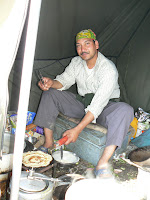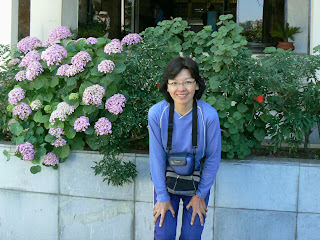I woke up at about five. Through the ‘roof’ of the tent, I could see that the sky was bright and clear. Feeling warm and comfortable inside the sleeping bag, I decided to laze around for a while longer.
Finally I got up. I stepped out of the tent, greeted the new day with open arms, took a deep breath and exclaimed ‘
what a wonderful day’!
I went to the stream to collect some water for washing. On the way, I passed by the kitchen tent. I saw Ram and Sangy already up and about, busy preparing breakfast and lunch. We greeted each other.
On the way back to the tent, I met Tek.
‘Did you have a good sleep last night?’
‘Oh yes, very well, thank you,’ I responded.
When I returned to the kitchen/dining tents area an hour later, I saw that the makeshift breakfast table – which was a storage trunk – was already set up in the open next to the dining tent. Laid on top of the ‘table’ were cereals, omelette, toast, tea and coffee. At both sides of the ‘table’ and on the ground were rubber mats.
Outdoor breakfast under the sun! – ‘this is incredible’, I thought. Had I expected all these? No, not at all.
By 8.45, we left the campsite, all ready to charge on. We were heading for camp 2 in Ranisui at 4,268m.
The trail was generally not as steep as the day before but the landscape was indeed captivating.
As we journeyed along and gradually gaining heights, the panoramic view of the Pir Panjal range appeared much closer. Right along our pathway, the rolling hills were blanketed in beautiful white and yellow wild flowers. I was charmed and entranced by the picture-perfect landscape but felt dwarfed and insignificant amid the vast boundless mountain world.
The beautiful scenery had a therapeutic effect. It helped us forget that there were still miles ahead. Stopping along the way to take pictures and savour the majestic view helped to evaporate the tiredness away.
After walking for about three hours, the horses caught up with us, we let them passed. Shortly after, the horses stopped, we were stuck behind them. We were wondering what happened. Then we realised that we had encountered snow. We had to traverse across the slope on snow!
We were standing on a narrow ledge and our view was blocked by the horses and could not really see what Tek and the crew were doing. Then in between the horses, I had a glimpse that they were chiselling the snow in order to create a safe path for us and the horses to cross. We were stuck there for about 40 minutes.
After the horses, it was our turn. Both Chin and I were nervous about the crossing. The crew assisted us.
After crossing, we asked Ram if there were anymore. The reply was, ‘May be one or two more, not very sure, may be...,’ before he could finish, we encountered another one. Then another... In all, we crossed no less than eight. I was scared stiff at some as some of the crossings were quite long, and the slope was steep and seemed ‘bottomless’. It is not easy to walk on snow, let alone on the slope.
I slipped and fell a few times, so as Chin. During those ‘scary’ moments, I could not help but recalled the gunny sack race we used to take part in primary school. I remembered how I would fall clumsily trying to walk as fast as I could in the gunny sack. I imagined that was how I look when I stumbled and fell on the snow field – minus the gunny sack!
We stopped for lunch at around one o’clock. It was a quick lunch of 15 minutes before we resumed our journey.
After about half an hour’s walk on a gentle slope, we started to ascend, steep one. Suddenly I heard the crew’s voice above us high at the top of the slope. I looked up and saw them. I felt something was amiss as they were much ahead of us. By then they should be way ahead.
Tek looked up and talked to them in their language. We asked what was happening. Tek then said that they encountered thick snow ahead on a very steep trail and felt that it might not be possible for the horses to pass. Tek then went up to take a look and asked us to stay put at where we were.

We waited. A minute seemed like an hour. We could see Sangy with the horses at the top of the slope. We asked where the rest were and were told that they had gone further up to check out the situation. We started to feel chilly sitting and waiting out in the open for so long, so we decided to walk up to join Sangy.
As soon as we reached the top, we saw Tek, Ram and Jhaba Ram coming down the slope in the distance. The whole place was covered with thick snow. It was an arresting sight, but the thought of having to cross it...!
Arh, perhaps the saying ‘I’ll cross the
bridge when I get to it’ should be ‘I’ll cross the
snow when I get to it’ instead.
Tek told us that there was a place where a very steep slope was covered with thick snow and that it was impossible for the horses to go up under such condition. He went on to explain that based on the original plan, we were supposed to go to where the thick snow on the steep slope was, cross the ridge, down to the other side and camp at Ranisui (camp 2) for a night before trekking up to Manali Pass the following day. But with the situation we faced, we had two options:
First option – contact the Manali office and ask them to send a group of porters to go with us to camp 2, i.e. as per the original plan minus the horses.
Second option – to descend back to where we had lunch earlier, camp there for a night, then trek up to Manali Pass the following day.
After a brief discussion, we decided to go for the second option. And so we started to descend, with a tinge of sadness and disappointment. (This meant that our five-day trek itinerary was drastically changed, at least half of it. But we felt that perhaps that was a better and more economical option.)
We then came to a place where we had to walk down the snow field. The slope was quite gentle and Tek informed that we could slide down if we wished. We tried, it was fun. We decided to slide all the way down. Then I got stuck, somehow my body refused to move while Chin was going down so fast that she was screaming, ‘
Arh, how to stop, how to stop?’ I really enjoyed that though perhaps it must have been quite a comical sight.
So, our new home for the night was at Riyali Thatch at about 4,000m. Soon after we arrived, the weather took a sudden change. It became very cold and extremely windy.
After a short while, the rain was pelting and the wind slashing hard on our tent. Nothing much we could do other than staying inside the tent talking, joking and laughing. We talked about how funny or silly we must have appeared when we fell, and how much we had enjoyed our journey so far. Though there were only two of us, fun and laughter were never in short supply.
Garlic soup, chilli chicken, fried cauliflower,
dal, rice and dessert – that was what we had for dinner. After the hearty meal, it was campfire time again.
When Ram and company had finished with their day’s chores, they joined us. We all stood around the fire, one minute facing the fire and the other, against it – just to make sure we got warm all round! (Does that make us sound like lamb kebab on rotisserie!?)
The men seemed to be ‘men of few words’ to the two ladies. They preferred to talk among themselves. And so, Chin and I had to make do with the incomprehensible Hindi while trying to keep ourselves warm.
After about an hour of standing by the fire, we called it a night. As we were walking back to our tent in the cold and windy night, I thought to myself, ‘What a day it has been!’
I crept into the warmth of my sleeping bag hoping for another good night sleep. Unfortunately, it did not come as easily as the previous night. I tossed and turned, drifting in and out of dream land. I resorted to counting sheep...1, 2, 3...!




















